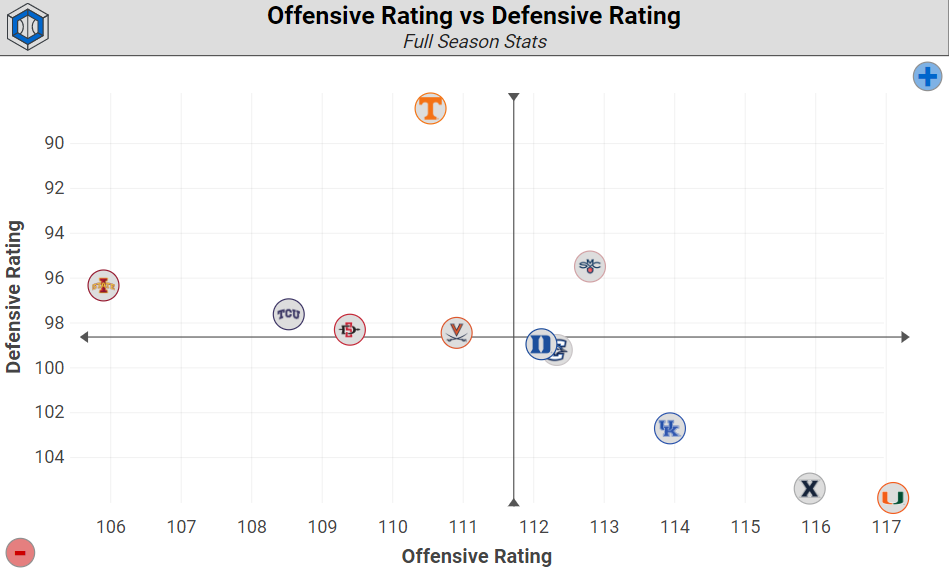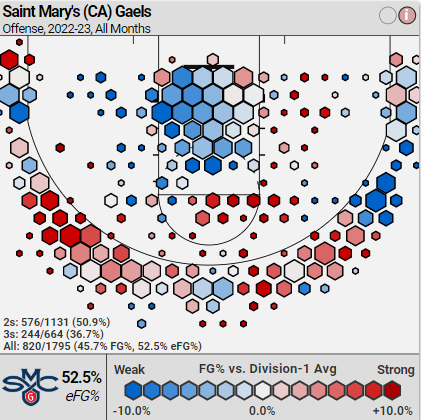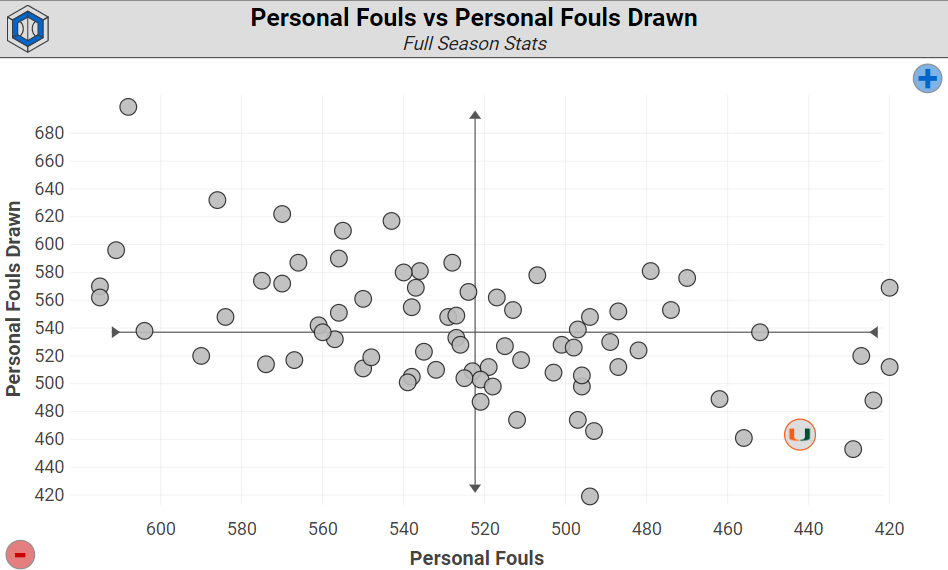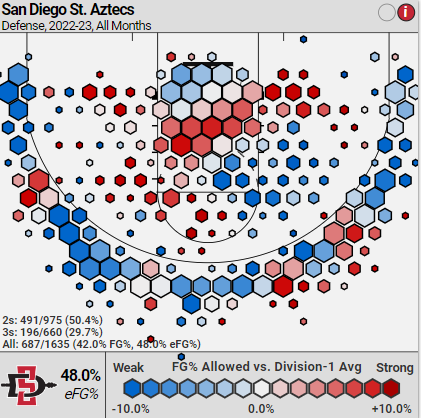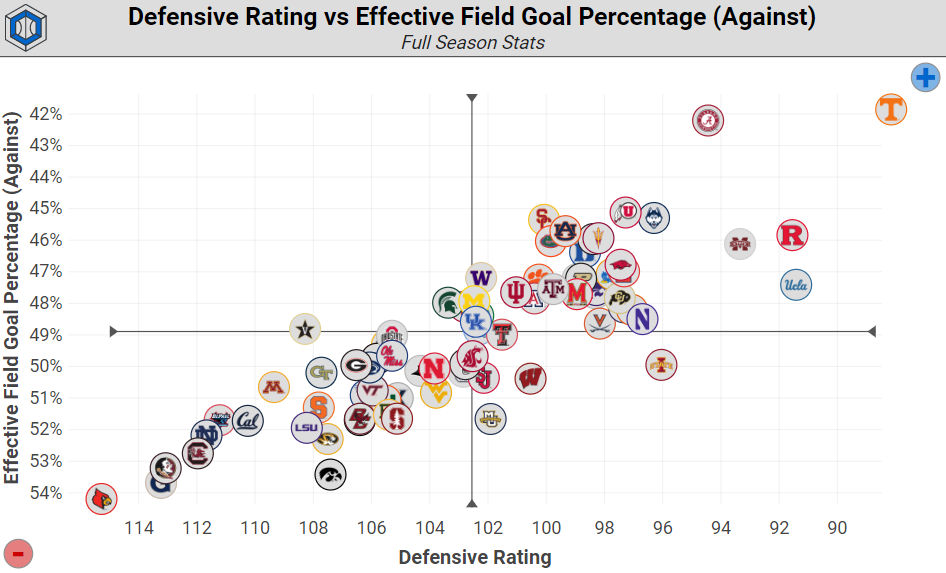Selection Sunday is nearly here, and in most bracketology, Indiana is slotted at the 4 seed. I will not claim to be a bracketology expert, but there are several opponents Indiana could match up against as the Tournament progresses. So I looked at their statistical profiles to prepare us all for what Indiana’s corner of the bracket might suggest about the Hoosiers’ hopes.
I worked on the assumption that all higher-seeded teams would defeat their First round opponents – a dangerous game, I know. Then I placed them in groups based on how I would feel if Indiana were to play them.
As I watch the bracket be revealed, I will be keeping a close eye on the 5th seed (who IU might play in the Second Round) and the No. 1 seed (who IU might play in the Sweet Sixteen). This could all mean nothing if Indiana loses in the First Round, which is not entirely out of the question.
Below is the first part of the Selection Sunday Guide for Indiana fans. This specific newsletter will discuss potential 5th seeds. Stay tuned for the potential 1st seeds this weekend!
First is the No. 5 seed. These are the teams who have a chance of landing in that 5th-seeded spot next to Indiana. Here is a graphic to show where each of them stands in offensive and defensive efficiency.
Source: CBB Analytics
To start, we need a quick statistical profile of Indiana for comparison. I’ll spare the strengths and weaknesses, since most folks reading this likely already know those about Indiana.
Indiana (21-10)
KenPom ranking: 31
Record vs. Quad 1 (T-rank): 5-8 (54th)
Top Performers: Trayce Jackson-Davis (20.5 points/game, 11.0 rebs/game, 3.9 assists/game, 2.8 blocks/game, Big Ten Defensive Player of the Year), Jalen Hood-Schifino (13.5 points/game, 4.1 rebs/game, 3.8 assists/game)
Any Indiana kids?: Um, a few…
Resume:
Good wins: @Xavier, vs. North Carolina, Illinois (2 times), vs. Michigan State, Purdue (2 times), vs. Rutgers, Michigan (2 times)
Notable Losses: Northwestern (2 times), Iowa (2 times), @Penn State
Indiana’s statistical profile is not too impressive when compared to other teams on this list. Injuries have certainly contributed to that, and Trayce Jackson-Davis’ outstanding play has given new life to a team that looked dead in the water in January. And any time a team can rip off an 11-4 run in the Big Ten to end a season, there is some fight there that transcends a statistical profile. Indiana seems to have that. It’ll be interesting to see how it translates to tournament play.
Below, the teams are split between three categories:
Feeling Good! - meaning I feel good about the matchup
Feeling Less Good - meaning I feel slightly nervous about the matchup when compared to “Feeling Good!”
*Tugs at shirt collar nervously* - meaning that these games might not end well for Indiana
Feeling Good!
Creighton (21-11)
KenPom ranking: 12
Record vs. Quad 1 (T-rank): 3-8 (38th)
Top Performers: Ryan Kalkbrenner (15.1 points/game, 6.3 rebs/game), Trey Alexander (13.7 points/game, 4.1 rebs/game)
Any Indiana kids?: No
Resume:
Good wins: Arkansas, vs. Providence, vs. Xavier, vs. Connecticut
Notable Losses: vs. Nebraska, BYU, Arizona State, @Villanova
Creighton boasts the 17th most difficult schedule in the nation, and it showed every bit of it early on, as the Bluejays lost six straight in December. The strongest win Creighton earned on the road was at Seton Hall, but its other, most notable wins came in home-dominant performances. Finding strong wins is difficult on this Creighton schedule, and a 3-8 record in Quad 1 games supports any skepticism of this team. Creighton also stumbled its way toward the end of the regular season by going 3-3, with its last win over a top-50 opponent coming on February 11.
Strengths:
An interesting stat about Creighton is that it boasts the 14th-best defensive efficiency while also owning steal and block percentages outside of the top-100. And even though Creighton is 7th in two-point defense since the New Year, teams score 59% of their points against Creighton from two, well above the 50.8% national average. And while facing the 9th-highest three-point rate, teams only score 27% of their points from three, below the 31% average. All of this while the Bluejays allow the second-lowest free throw rate. So there might not be many turnovers or blocks, but good luck scoring.
And on the other end, Creighton owns the 26th-best effective field goal percentage in the nation, but it doesn’t score inside as often as one might think for a team with a 7-foot, First Team All-Conference center (Kalkbrenner). Only 49% of its points come from two despite the 22nd-best 2-point percentage in the country and with Kalbrenner shooting 71.2% effectively from the field (2nd-best in the nation). Creighton does shoot from three, attempting nearly 25 threes per game. This creates some spatial advantages.
Weaknesses:
A huge weakness for this Creighton team is its depth. It ranks 350th in bench minutes, and four of its starters are used on 20-24% of possessions. Only one man outside of the starting five averages double-digit minutes per game.
While Creighton was also battle-tested early in the season, with the 10th-most difficult schedule in the nation and an early 6-game losing streak, Crighton was able to turn it around. But the Bluejays lost 3 of their last 6 games to end the regular season and saw dips in most statistical categories, particularly 2-point scoring, and rank 36th in the nation since Feb. 14.
On a micro level, the Bluejays, while ranking 12th in the nation in defensive rebounding, rank 253rd in offensive rebounding. They also don’t go to the free throw line often on offense.
Duke (24-8)
KenPom ranking: 26
Record vs. Quad 1 (T-rank): 3-6 (82nd)
Top Performers: Kyle Filipowski (15.2 points/game, 8.9 rebs/game), Jeremy Roach (13.0 points/game, 3.3 assists/game)
Any Indiana kids?: No
Resume:
Good Wins: Xavier, vs. Miami (FL). North Carolina (2 times), Iowa
Notable Losses: Purdue, @Wake Forest, @NC State, @Clemson, @Virginia Tech, @Miami (FL), @Virginia
It’s difficult to tell if Duke’s resume has any teeth to it. The ACC was weak this year, and its only losses in conference came on the road, though some of them (Virginia Tech, Clemson, Wake Forest, and even NC State) are fairly unforgivable. The Blue Devils six straight to close the regular season, but only one (UNC) was a Quad 1 opponent. A 28-point win over Pitt was encouraging for Duke fans, though.
Strengths:
Perhaps what Duke does better than other teams on this list is rebound. The Blue Devils rank 12th in the nation in rebounding and are the 6th-best offensive rebounding team. They’re also the No. 1 team in roster height. Chief among the frontcourt contributors is 7-foot freshman center Kyle Filipowski, who ranks 58th in the country in defensive rebounding percentage. Senior 6-foot-10 forward Ryan Young ranks 13th in offensive rebounding percentage. It’s rare for this team to rebound well and lose games. However, defensive rebounding has been spotty at times.
This size in the frontcourt also translates to the 6th-best 2-point defense against Quad 2-plus teams. When the quality bumps to Quad 1, though, Duke’s 2-point defense falls to 69th-best. It’s defensive rebounding also falls to 116th.
Weaknesses:
There is a clear line where Duke’s 74th-toughest schedule shines through, as its T-rank is 45th against Quad 2-plus teams but falls to 82nd against Quad 1 teams, of which it’s only played 9 games. Their offense also tumbles to 177th against Quad 1 teams. Duke simply hasn’t played many Quad 1 games, and when it has, it’s playing below the bubble. While it does allow the 37th-lowest effective field goal percentage and the 43rd-lowest 3-point percentage, much of the edge from its frontcourt is lost.
Kentucky (21-10)
KenPom ranking: 22
Record vs. Quad 1 (T-rank): 6-7 (36th)
Top Performers: Oscar Tshiebwe (16.4 points/game, 13.1 rebs/game), Antonio Reeves (14.2 points/game), Jacob Toppin (12.3 points/game, 6.8 rebs/game)
Any Indiana kids?: No
Resume:
Good Wins: Michigan, Tennessee (2 times), vs. Texas A&M, vs. Auburn, @Arkansas
Notable Losses: @Missouri, vs. South Carolina, @Georgia, vs. Vanderbilt
Since December, Kentucky has had some baffling losses at least once per month – Missouri in December, home to South Carolina in January, at Georgia in February, and even at home against Vanderbilt in March. This team seems primed for an early exit from the Tournament at this rate. There are also few good wins throughout the season for the Wildcats, but recent wins over Mississippi State, Tennessee, Florida (on the road), Auburn, and Arkansas (on the road) have earned a place here for Kentucky.
Strengths:
Kentucky is generally a strong offense, with a T-rank of 37th in Quad 1 play, but since the beginning of February, that number is up to 6th. Oscar Tshiebwe, a 6-foot-9 forward, plays the five for Kentucky and is one of the strongest individual players in the Tournament, averaging 16.4 points per game and 13.1 rebounds per game. He owns the 62nd Offensive Rating, the No. 2 offensive rebound rate, and the No. 11 defensive rebound rate in the country. As a team, Kentucky has dominated the boards, even in Quad 1 play.
Antonio Reeves, Kentucky’s second leading scorer, is also lethal from three, hitting 41% of his threes and attempting 5.6 per game.
Weaknesses:
Kentucky doesn’t have many scoring threats outside of Tshiebwe and Reeves. In Quad 1 play, they shot 46.7% effectively from the field, which ranks 150th in the nation, and from two, where they score 56.2% of their points (33rd in the country), their 47.9% is 111th in the country.
Defensively, it’s a bit of a mess for Kentucky. They’re about average in steal percentage and also are near the bottom in non-steal turnovers forced. Since February began, Kentucky’s defense has shown a slight improvement, but their defensive effective field goal percentage still hovers around 80th in the nation.
Saint Mary’s (26-7)
KenPom ranking: 11
Record vs. Quad 1 (T-rank): 2-3 (59th)
Top Performers: Logan Johnson (14.7 points/game, 4.8 rebs/game, 3.7 assists/game, 1.5 steals/game, WCC Defensive Player fo the Year), Aiden Mahaney (14.5 points/game, 2.0 assists/game)
Any Indiana kids?: No
Resume:
Good Wins: San Diego State, vs. Gonzaga, BYU (3 times)
Notable Losses: Washington, vs. New Mexico, vs. Colorado State, @Loyola Marymount, Gonzaga (2 times)
Playing in the WCC offers few opportunities at Quad 1 competition, but Saint Mary’s has played five Quad 1 games and finished 2-3 in those games with a Bart Torvik T-rank of 59th in the country in those games. Wins over Gonzaga and San Diego State carry much of the strength in their resume, but a few tough losses dot their schedule and show some inconsistencies. A 77-51 loss to Gonzaga in the conference tournament also leaves a bad taste in the public’s mouth.
Strengths:
Saint Mary’s has an extremely disruptive defense. The Gaels are ranked 9th in defensive efficiency, and that peskiness reflects in some key stats, such as allowing the 27th-lowest effective field goal percentage in the nation, allowing the 3rd-fewest assists per field goal attempt, recording the 5th-highest steal percentage, allowing the 2nd-fewest total rebounds, playing at the 4th-slowest pace (average possession length of 20.4 seconds!), and allowing the 5th-fewest points per game (60.1). They are the definition of disruptive, and their 6-foot-2 point guard is also the WCC Defensive Player of the Year. All of these, when passed through the filter of their 14 Quad 2-plus games this year, are still impressive too.
Weaknesses:
It’s bizarre but even while ranking 16th in 2-point defense against Quad 2-plus teams, Saint Mary’s struggles to score inside. Below is their heat map.
Source: CBB Analytics
Saint Mary’s is basically a 6-foot-10 center surrounded by guards when on offense, as its 6-foot-8 forward mostly plays defense, crashes the boards, and shoots threes, averaging 5.3 points per game and 7.2 rebounds. Outside of their center, Mitchell Saxen, no starter averages fewer than 2.5 threes attempted per game, and they hit them, boasting a 3-point percentage of 37.2%, which is 40th in the nation.
Their depth situation is a major disadvantage too. The starting five all average more than 30 minutes per game, and within that, Bowen – the four – plays 82% of available minutes and is used on just 9% of offensive possessions. Logan Johnson plays 85% of available minutes. Aidan Mahaney, who made the All-WCC First Team is a freshman.
Feeling Less Good
Miami (25-6)
KenPom ranking: 40
Record vs. Quad 1 (T-rank): 5-4 (18th)
Top Performers: Isaiah Wong (15.9 points/game, 3.4 assists/game, ACC Player of the Year), Jordan Miller (15.1 points/game, 6.1 rebs/game)
Any Indiana kids?: Nijel Pack, Lawrence Central (13.4 points/game)
Resume:
Good wins: Providence, vs. Rutgers, vs. Virginia, vs. Duke, @North Carolina
Notable Losses: @Georgia Tech, @NC State, @Pitt, vs. Florida State
There aren’t many big wins to be had in the 91st-ranked schedule, and there are a few bad losses, including to No. 208 Florida State on Feb. 25. But Miami being 5-4 in Quad 1 games goes a long way in explaining the identity of this team. So does having Isaiah Wong, the ACC Player of the Year, on their roster. It’s not a great resume and not even a great roster, but something about Miami makes me a bit nervous compared to some other teams on this list.
Strengths:
Offense. Miami is ranked 13th in offensive efficiency by KenPom and converts consistently from most areas of the court (42nd in 2-pt%, 29th in 3-pt%), though the Hurricanes, like the Hoosiers, don’t attempt many threes. Since the New Year, Miami ranks 5th in the country in 3-point percentage but attempts the 237th-most threes, with 20.5 (IU is 24th in 3-pt% since the New Year and 352nd in attempted threes, with 15). It’s essentially a two-man party from three for Miami, as Pack (6.1) and Wong (4.5) take about half the team’s threes per game and are legitimate threats from behind the arc in any game, particularly Pack.
Largely though, this team scores from inside.
Weaknesses:
Defense has been a struggle for Miami this season. The Hurricanes rank 122nd in defensive efficiency by KenPom, and since the New Year, Miami is 300th in defensive 2-point percentage. Trayce Jackson-Davis would have a day against Miami. One of the primary reasons for these struggles defensively is the size disadvantage, as Miami ranks 224th in roster height and has a 6-foot-7 center, and its tempo (ranked 102nd) is only slightly above the national average.
Also, don’t worry about foul trouble. Miami is one of the worst teams in personal foul ratio – 344th in personal fouls committed and 334th in personal fouls drawn.
Source: CBB Analytics
San Diego State (25-6)
KenPom ranking: 15
Record vs. Quad 1 (T-rank): 4-5 (15th)
Top Performers: Matt Bradley (13 points/game, 3.9 rebs/game), Nathan Mensah (6.6 points/game, 5.8 rebs/game, 1.5 blocks/game, MWC Defensive Player of the Year)
Any Indiana kids?: No
Resume:
Good Wins: Ohio State, vs. Nevada, Utah State (2 times), vs. Boise State, @New Mexico
Notable Losses: Arizona, Arkansas, Saint Mary’s, vs. New Mexico
San Diego State ended its regular season without a loss to a team outside of the KenPom top-50 but without a win against a top-20 team. Yet, against Quad 2-plus teams, San Diego State is 9-6 and is ranked 11th in Bart Torvik’s T-rank.
Strengths:
SDSU has insane depth. No player averages more than 28 minutes per game, and 10 players average double-digit minutes per game. Because of this depth, San Diego State has at least one player in the top-100 of each of the following KenPom stat categories: Offensive Rating, offensive rebounding percentage, block percentage, steal percentage, fouls drawn per 40 minutes, and 3-point percentage.
The Aztecs employ a strong perimeter defense, allowing just 30.6% from three (16th-best in nation), which is notable because inside awaits 6-foot-10 center Nathan Mensah, who recorded the 20th best Defensive Rating since 2009-10 last season (according to Sports-Reference.com). There’s been some regression from then for Mensah, but he’s still the MWC Defensive Player of the Year. He owns the 26th-best block percentage in the country this year too.
There’s also a ton of experience on this team. Six seniors and two juniors populate the 10-man rotation. Adam Seiko is one of those seniors, and he owns the 48th-best Offensive Rating in the nation and shoots 48.4% from three.
Weaknesses:
San Diego State turns the ball over more than other teams Indiana could potentially play in the Second Round, with a turnover percentage that ranks 150th in the country and 90th against Quad 2-plus teams. Each player that averages double-digit minutes averages more than one turnover per game.
Even though Mensah awaits on defense inside, teams have been able to find some success inside against San Diego State, shooting 50.6% from two, and that’s without the mid-range success Indiana has found in 2023. That 2-point percentage ranks 200th in the nation defensively for SDSU.
Source: CBB analytics
TCU (21-11)
KenPom ranking: 24
Record vs. Quad 1 (T-rank): 8-10 (33rd)
Top Performers: Mike Miles (17.2 points/game, 2,6 assists/game, 1.2 steals/game), Damion Baugh (13.0 points/game, 6.0 assists/game, 1.9 steals/game)
Any Indiana kids?: No
Resume:
Good Wins: Iowa, vs. Providence, @Baylor, vs. Kansas State, @Kansas, vs. West Virginia, vs. Texas
Notable Losses: vs. Northwestern State, vs. Iowa State, @Oklahoma State, @Oklahoma
Any Big 12 team is going to have a strange resume due to its strength this year, and finishing 5th in that league this year is impressive. You won’t find many schools, if any, outside of the Big 12 that have played 17 Quad 1 games. TCU is 7-10 in those games and ranks 37th in T-rank. Their recent conference tournament victory over Kansas State only bolstered this resume.
Strengths:
TCU ranks 14th in bench minutes nationally, with 10 players averaging double-digit minutes per game. This means TCU has a lot of versatility in the lineups it can deploy and also allows TCU to operate at a fast tempo, 47th-fastest in the nation. The two players who are on the floor for 30-plus minutes, though, are Second Team All-Big 12 guards Mike Miles and Damion Baugh. Both are the primary facilitators (Baugh averages 6.0 assists per game, 71st in assist rate) and make their money inside as the team’s leading scorers (a combined 30.2 points per game) but are rarely threats from three. In fact, the rate at which Miles draws fouls is 92nd in the country because of his ability to drive to the basket. TCU also sits at nearly the bottom of the country in 3-point rate and 3-point percentage, so this team does its scoring inside at a fast rate.
Weaknesses:
Defense has been more of a struggle for TCU. They rank 50th in defensive efficiency, and the assist rate they allow to opponents is ranked 307th in the country. Since limiting Kansas to 60 points 12 games ago in January, teams have averaged 72.5 points per game against TCU. The Horned Frogs do a good job of limiting 3-point offense, but the rate at which teams score from two ranks 144th in the nation.
Lastly, they won’t steal many possessions, block many shots, or shoot many threes, but what stands out the most is their free throw performance. Against Quad 2-plus opponents, TCU will get to the line at a rate that ranks 100th in the nation, but its free throw percentage (70%) is below the national average.
Virginia
KenPom ranking: 37
Record vs. Quad 1 (T-rank): 5-4 (40th)
Top Performers: Armaan Franklin (12.6 points/game, 4.2 rebs/game), Kihei Clark (11.1 points/game, 5.7 assists/game), Reece Beekman (9.3 points/game, 5.3 assists/game, 1.6 steals/game, ACC Defensive Player of the Year)
Any Indiana kids?: Armaan Franklin, Cathedral
Resume:
Good wins: Baylor, Illinois, @Michigan, vs. North Carolina, vs. Duke
Notable Losses: @Miami (FL), @Pitt, @Virginia Tech, @Boston College
Like Miami, there were few good wins to have on this schedule, which ranks 82nd in the nation. And a couple losses that stand out are an 8-point loss to Houston and a stunning 15-point loss to Boston College on Feb. 22. There is little to support the idea that this team is good, but it’s hard to believe a Tony Bennett tem with Armaan Franklin wouldn’t be difficult to deal with in the Tournament.
Strengths:
As usual, Tony Bennett’s team is defensively sound, ranking 31st in defensive efficiency and 9th in points allowed per game. Reece Beekman was also named ACC Defensive Player of the Year. All around, they’re a pretty sound team fundamentally too, with the 2nd-most assists per field goal, the 6th-best turnover ratio, and committing just 14 personal fouls per game. To date, this team has only played Miami (FL) once (in December) and held that offense to 66 points in Miami, despite a 66-64 loss.
Weaknesses:
That leads us into Virginia’s primary weakness: scoring. The Cavaliers have scored 70-plus points against top-100 teams only 5 times and only twice since the New Year. This is partially responsible for why they lost to KenPom No. 175 Boston College on Feb. 22, 63-48. Only one Cavalier hit double-digits in that game, and leading scorer Armaan Franklin scored 4 against a BC defense that ranks 125th in efficiency. It takes very little resistance to limit the Virginia offense, which, since the New Year, ranks 183rd in effective field goal percentage, 294th in free throw rate, and 224th in 2-point percentage.
*Tugs at shirt collar nervously*
Iowa State (19-12)
KenPom ranking: 20
Record vs. Quad 1 (T-rank): 10-10 (26th)
Top Performers: Gabe Kalscheur (12.7 points/game, 1.5 steals/game, All-Big 12 Defensive Team), Jaren Holmes (13.2 points/game, 3.7 rebs/game, 3.3 assists/game, 1.1 steals/game), Tamin Lipsey (4.6 assists/game, 3.6 rebs/game, 2.1 steals/game)
Any Indiana kids?: No
Resume:
Good Wins: Baylor (3 times), TCU (2 times), vs. Kansas, vs. Texas, vs. Kansas State
Notable Losses: @Iowa, Oklahoma State (2 times), vs. Oklahoma, @Missouri, @Texas Tech
As discussed with TCU, any Big 12 team is going to have a strange resume because of the strength of its conference this year. For example, losing to Oklahoma State twice looks tough through the Big 12 lens, but the Cowboys are rated by KenPom as the 39th team in the country. So in Quad 1 play, Iowa State is 10-10 and ranks 26th in the nation. It also owns the 5th-toughest schedule in the nation. While Iowa State has stumbled into the end of the regular season, the Cyclones have rebounded a bit with road and neutral wins over Baylor. This isn’t exactly a team I’d personally want to face.
Strengths:
Iowa State’s backcourt is its strength. Beginning with Gabe Kalscheur, who was named Second Team All-Big 12 and to the All-Big 12 Defensive Team. He switches between the two and three and averages 1.5 steals per game, though his Defensive Rating is only at 98 points allowed per 100 possessions. Jaren Holmes, a transfer guard from St. Bonaventure, mostly plays off the ball but will also handle point guard duties, as he is second on the team with 3.3 assists. He’s also the leading scorer, with 13.2 points per game, and is active on defense. Then, Iowa State’s primary point guard is freshman Tamin Lipsey, who runs point 79% of the time and averages 4.6 assists and 2.1 steals per game. These three lead Iowa State’s efforts on both ends of the floor, contributing to a 7th ranked defensive efficiency, but certainly will turn the ball over at times.
It should also be noted that 6-foot-10 center Osun Osuniyi owns the 20th-best block percentage in the nation. Scoring on this team is tough, as it allows just 62.2 points per game. In Quad 2-plus games, Iowa State forces turnovers at the 16th-best rate and owns the glass with the 34th-best offensive rebounding rate and the 66th-best defensive rebounding rate.
Weaknesses:
Of the teams Indiana could play in the Tournament, Iowa State has one of the weakest offenses, only scoring 68.5 points per game and ranked 90th in efficiency. This is strange for a team that forces as many turnovers as Iowa State, but the Cyclones run one of the slowest tempos in the country. Their turnover percentage is also 262nd in the nation, and only 15.6% of their points come from the free throw line because they don’t get to the line and then also shoot a dismal 67.3% from the free throw line. There is no serious threat to score from Iowa State, and if a team can limit its 2-point scoring, where it ranks 72nd against Quad 2-plus opponents, then it’s a defensive slug-fest.
Tennessee (23-9)
KenPom ranking: 5
Record vs. Quad 1 (T-rank): 7-6 (11th)
Top Performers: Zakai Zeigler (10.7 points/game, 5.4 assists/game, 2.0 steals/game), Santiago Vescovi (12.7 points/game, 4.6 rebs/game, 3.0 assists/game, 1.9 steals/game)
Any Indiana kids?: No
Resume:
Good Wins: Kansas, Maryland, vs. Texas, vs. Alabama, vs. Arkansas, USC
Notable Losses: Colorado, Kentucky (2 times), @Florida, @Vanderbilt, @Missouri, @Auburn
Before February, Tennessee appeared to be one of the top-five teams in the country, but after that, the Volunteers ended their regular season on a 4-6 streak ranked 31st in the nation by Bart Torvik. Losses to Florida, Vanderbilt, and Missouri stand out. But the non-conference wins remain notable, and this team is still dangerous.
Strengths:
You can’t talk about Tennessee without discussing its defense, which is ranked No. 1 in efficiency and is head and shoulders above the No. 2 defense too.
Source: CBB Analytics
Tennessee allows teams to shoot just 44.1% from two and 25.5% from three, and the only one of those two figures that has changed since January is 3-point shooting, which has jumped to 33%. Add Tennessee’s top-20 rebound rate, and every possession is crucial.
Weaknesses:
Tennessee’s offense can really struggle against good defenses. The Volunteers are ranked 202nd in effective field goal percentage, 170th in turnover percentage, and between the three scoring methods (3-pt%, 2-pt%, and FT%), their best ranking is a 153rd-best 2-point percentage. They rely on ball movement, with the second highest assist rate in the nation, but that can be disrupted.
Also, since February began, some inconsistencies have begun to show. Tennessee has been known to send teams to the free throw line, and Kentucky and Texas A&M took advantage of that. Missouri shot 14-of-26 from three, and Florida broke through and shot 50% from two.
Xavier (24-8)
KenPom ranking: 16
Record vs. Quad 1 (T-rank): 7-5 (17th)
Top Performers:
Any Indiana kids?: Jack Nunge, Castle H.S.
Resume:
Good Wins: vs. West Virginia, Connecticut (2 times), @Villanova, Providence (2 times), vs. Creighton, vs. Marquette
Notable Losses: vs. Indiana, @DePaul, @Butler, vs. Villanova
February was the toughest month since November for Xavier, but a couple wins against Providence, particularly the one on the road on March 1, have helped steady the ship. It’s difficult to tell if Xavier has come out of February better or not because, outside of its two games against Providence, it hasn’t had a high-quality win since beating Connecticut on the road on Jan. 25. But one thing is for sure: this Xavier team is not the same Xavier team that Indiana defeated in Cincinnati thai past November.
Strengths:
Xavier is one of the few teams on this list that are stronger offensively than defensively. They ranked 6th in offensive efficiency, with Souley Boum at 86th in Offensive Rating and Jack Nunge at 74th. Two more Musketeers are inside the top-300. They run at a tempo that ranks 31st-fastest in the country and add lots of ball movement, the 6th-best assist rate. All five starters, who play a majority of the minutes, average double-digit scoring. They all shoot 45% or better from the floor and 40% or better from three, even though they attempt the 288th-most threes in the nation. The versatility of the offense with options to score or facilitate from anywhere on the floor is what makes this team strong.
Weaknesses:
Xavier’s defensive efficiency is ranked 90th this season. They allow teams to shoot 36.4% from three (311th nationally) and are below average in both block percentage and steal percentage. They also rank 265th in assist rate allowed, so teams can move the ball basically wherever they want against Xavier. In their last four Quad 1 games, however, there seems to be improvement, as the Musketeers rank 51st in defensive effective field goal percentage, especially from two. That’s not lights out, but it’s better than its season-long figure against Quad 1 teams, which ranks 133rd.
Stay tuned for the No. 1 seeds coming soon in Part 2!






